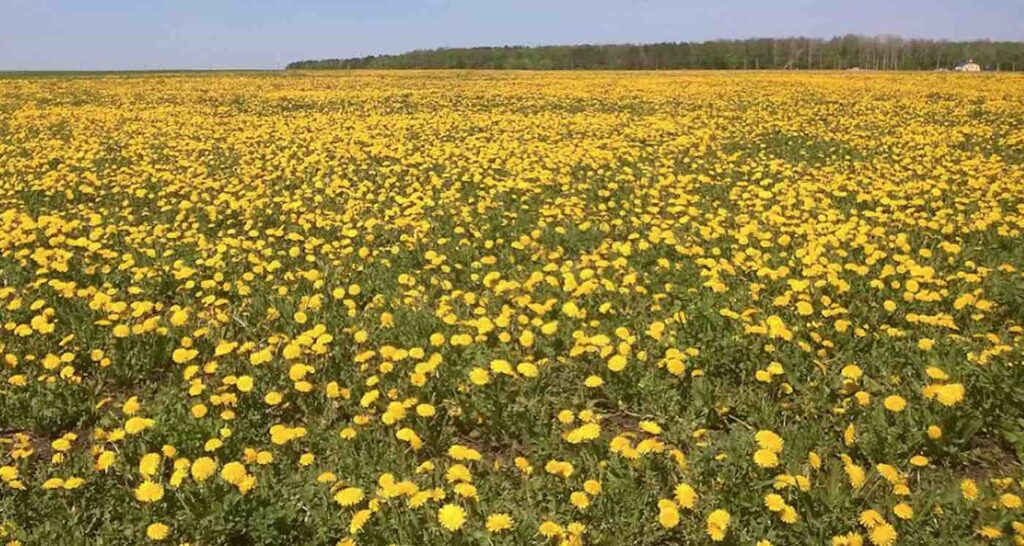
Turns out that a specific variety nicely matches the quality of rubber from the rubber tree. Better yet, the entire plant is grabbed, cleaned up and ground. Separation is done with hot water alone and no special solvents.
Nothing is said regarding the residue, but that can not be too far away from been cattle feed as well.
all of a sudden a dense field of maturing dandelions is a cash crop that must hit real tonnage because it includes the tap roots as well. One can also see multiple crops in one year as well.
This reminds me of the conversion of wild mustard to oil seed production.
Rubber Made From Dandelions is Making Tires More Sustainable – Truly a Wondrous Plant
By Andy Corb
https://www.goodnewsnetwork.org/dandelions-produce-more-sustainable-rubber/
as companies continue to search for more environmentally regenerative materials to use in manufacturing, the tire industry is beginning to revisit an old Soviet method of rubber cultivation, using a plant that is considered a pesky weed in the West—dandelions.
Dandelion field in Russia by Vadim Indeikin, CC license
A major tire company in Germany has partnered with the University of Aachen to produce dandelion rubber tires in a bid to cut back on landfill waste, microplastic pollution, deforestation, and economic shortcomings related to rubber tree cultivation.
While the concept of “dandelion rubber” seems like a Harry Potter spell waiting to happen, as mentioned previously, it was actually developed by the Soviet Union in their quest for self-sufficiency.
Reporting from DW tells the story of a scavenger hunt across the largest country ever, and the testing of more than 1,000 different specimens before dandelions growing in Kazakhstan were found to be a perfect fit.
Previously, the world used the rubber trees, mostly Hevea brasiliensi, from Brazil, but during the Second World War the major powers of the USSR, UK, US, and Germany, were all cultivating dandelions for rubber manufacturing.
After the war ended, demand and supply gradually returned to Brazil and eventually to synthetic tires made from petrochemicals.
Aiding the bees and our environment
Now, Continental Tires is producing dandelion rubber tires called Taraxagum (which was inspired by the genus name of the species, Taraxacum). The bicycle version of their tires even won the German Sustainability Award 2021 for sustainable design.
“The fact that we came out on top among 54 finalists shows that our Urban Taraxagum bicycle tire is a unique product that contributes to the development of a new, alternative and sustainable supply of raw materials,” stated Dr. Carla Recker, head of development for the Taraxagum project.
The report from DW added that the performance of dandelion tires was better in some cases than natural rubber—which is typically blended with synthetic rubber.
Capable of growing, as we all know, practically anywhere, dandelion needs very little accommodation in a country or business’s agriculture profile. The Taraxagum research team at Continental hypothesizes they could even be grown in the polluted land on or around old industrial parks.
Furthermore, the only additive needed during the rubber extraction process is hot water, unlike Hevea which requires the use of organic solvents that pose a pollution risk if they’re not disposed of properly.
Representing a critical early-season food supply for dwindling bees and a valuable source of super-nutritious food for humans, dandelions can also be turned into coffee, give any child a good time blowing apart their seeds—and, now, as a new source for rubber in the world; truly a wondrous plant.
<iframe width="640" height="360" src="https://www.youtube.com/embed/bvVJL2GYRHY" title="YouTube video player" frameborder="0" allow="accelerometer; autoplay; clipboard-write; encrypted-media; gyroscope; picture-in-picture" allowfullscreen></iframe>
ay 15, 2
No comments:
Post a Comment